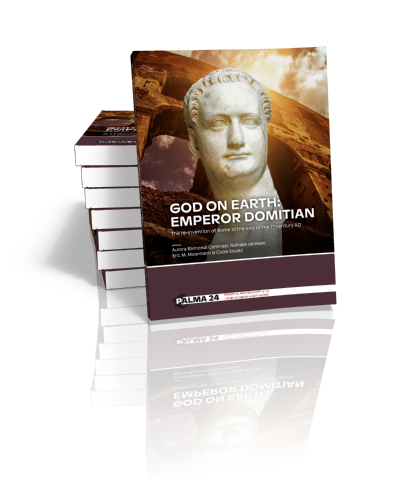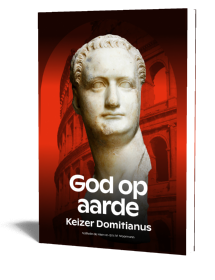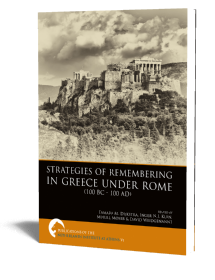God on Earth: Emperor Domitian
The re-invention of Rome at the end of the 1st century AD
Edited by Aurora Raimondi Cominesi, Nathalie de Haan, Eric M. Moormann & Claire Stocks | 2021

God on Earth: Emperor Domitian
The re-invention of Rome at the end of the 1st century AD
Edited by Aurora Raimondi Cominesi, Nathalie de Haan, Eric M. Moormann & Claire Stocks | 2021
Paperback ISBN: 9789088909542 | Hardback ISBN: 9789088909559 | Imprint: Sidestone Press | Format: 210x280mm | 224 pp. | Papers on Archaeology of the Leiden Museum of Antiquities 24 | Series: PALMA | Language: English | 56 illus. (bw) | 42 illus. (fc) | Keywords: Classical archaeology, Classical history, Domitian; Roman Empire; Flavian dynasty; ancient Rome; imperial power and representation; Anchoring Innovation | download cover
Read online 1379 times
- Digital & Online access
-
Buy via Sidestone (EU & UK)
-
Buy via our Distributors (WORLD)
For non-EU or UK destinations you can buy our books via our international distributors. Although prices may vary this will ensure speedy delivery and reduction in shipping costs or import tax. But you can also order with us directly via the module above.
UK international distributor
USA international distributor
-
Bookinfo
Paperback ISBN: 9789088909542 | Hardback ISBN: 9789088909559 | Imprint: Sidestone Press | Format: 210x280mm | 224 pp. | Papers on Archaeology of the Leiden Museum of Antiquities 24 | Series: PALMA | Language: English | 56 illus. (bw) | 42 illus. (fc) | Keywords: Classical archaeology, Classical history, Domitian; Roman Empire; Flavian dynasty; ancient Rome; imperial power and representation; Anchoring Innovation | download cover
Read online 1379 times

We will plant a tree for each order containing a paperback or hardback book via OneTreePlanted.org.
In life, the emperor Domitian (81-96 CE) marketed himself as a god; after his assassination he was condemned to be forgotten. Nonetheless he oversaw a literary, cultural, and monumental revival on a scale not witnessed since Rome’s first emperor, Augustus.
In tandem with an exhibition in the Rijksmuseum van Oudheden in Leiden and the Mercati Traianei in Rome, planned for 2021-2022, this volume offers a fresh perspective on Domitian and his reign. This collection of papers, produced by a group of international scholars, gives a holistic and interdisciplinary approach to the emperor and his works that begins with an overview of Rome and its imperial system and ends with a reappraisal of Domitian and his legacy.
The subject of memory sanctions after his death, Domitian’s reputation has suffered as a result of the negative press he received both in antiquity and thereafter. Building upon recent scholarship that has sought to re-evaluate the last of the Flavian emperors, the papers in this volume present the latest research on Domitian’s building programmes and military exploits as well as the literary sources produced during and after his reign, all of which paint a picture of an emperor who – despite being loathed by Rome’s elite – did much to shape the landscape of Rome as we know it today.
Preface: Anchoring a New Emperor
André Lardinois, Ineke Sluiter
Introduction: Domitian, the Neglected Emperor Who Wished to Be God
Aurora Raimondi Cominesi, Nathalie de Haan, Eric M. Moormann & Claire Stocks
Part 1: Ruling the Empire
Emperorship and Emperors before the Flavians Came to Power
Olivier Hekster
Rome AD 69: the City at the Crossroads
Domenico Palombi
The Rise of the Flavians
Barbara Levick
Impact of Empire: Cremona, Bedriacum and Brescia
Francesca Morandini, Lilia Palmieri, Marina Volonté
Part 2: Building the Empire
Domitian’s Reshaping of Rome
Eric M. Moormann
The Arch of Titus in the Circus Maximus
Claudio Parisi Presicce
Material Culture in Britannia under Domitian; a Northern Focus
Barbara Birley, Frances McIntosh
Domitian and the Lower German Limes (The Netherlands)
Jasper de Bruin
Part 3: The Image of the Emperor
The Image of the Emperor: Seeing Domitian
Jane Fejfer
Historical Reliefs and Architecture
Paolo Liverani
The Image of the Emperor in Contemporary Epic Poetry
Claire Stocks
Imperial Women and the Dynamics of Power. Managing the Soft Power of Domitia Longina and Julia Titi
Lien Foubert
Part 4: The World of Domitian
Living Like the Emperor: A Portrayal of Domitian in his Villas and on the Palatine
Aurora Raimondi Cominesi and Claire Stocks
Between Magnificence and Misery: Living Conditions in Metropolitan Rome
Nathalie de Haan
Entertainment and Spectacle during Domitian’s Rule
Daniëlle Slootjes
Domitian and the Capitolia
Onno van Nijf, Robin van Vliet, Caroline van Toor
Archaeological Evidence from Domitian’s Palatine
Natascha Sojc
Albanum Domitiani, Domitian’s Villa in Castel Gandolfo
Claudia Valeri
Part 5: Man and God
Domitian and Religion
Frederick G. Naerebout
Master and God: Domitian’s Art and Architecture in Rome
Diane Atnally Conlin
Man and God: Literature
Antony Augoustakis, Emma Buckley
Anchoring Egypt. The Iseum Campense and Flavian Rome
Miguel John Versluys
Part 6: Fall and Afterlife Regime Change/Reputation in Antiquity
Portraiture and Memory Sanctions
Caroline Vout
Domitian and the Temples of Egypt
Olaf E. Kaper
Domitian’s Damned Memory in the Fourth and Fifth Centuries
Maria Paolo Del Moro
‘An Enemy of God’ on the Imperial Throne? The Reception of Domitian during the Middle Ages
Nine Miedema
Bibliography
Index of Names, Places, and Subjects
Dr. Aurora Raimondi Cominesi
Aurora Raimondi Cominesi is project curator at the Rijksmuseum van Oudheden in Leiden. In 2019, she obtained her doctoral degree at Radboud University (Nijmegen, The Netherlands) with a dissertation titled The Past on the Wall. Anchoring Innovation in the Decoration and Architecture of the Imperial Residences on the Palatine. Her research focuses on mural paintings, domestic and public architecture, and includes studies on the Roman villas at Stabiae. She also has an interest in the digital challenges faced by museums today; she co-edited the guide (in Italian) Comunicare la cultura online: una guida pratica per i musei. Progettazione di siti web, content management, social media e analisi dei risultati.
Dr. Nathalie de Haan
Nathalie de Haan is senior lecturer in Ancient History at Radboud University (Nijmegen, The Netherlands). She published on Roman baths and bathing culture, domestic architecture, archaeology in Fascist Italy, and contributed with various publications to the field of Reception Studies, such as the recent volume Framing Classical Reception Studies, Leiden 2020, co-edited with Maarten De Pourcq and David Rijser. She is the author of Römische Privatbäder. Entwicklung, Verbreitung, Struktur und sozialer Status, Frankfurt am Main 2010. With Kurt Wallat she conducted research and excavations in the Central Baths of Pompeii (monograph forthcoming). Her current research interests include the multifaceted role of archaeology, heritage and the Classics in Italy in the 19th and 20th centuries.
Prof. dr. Eric M. Moormann
Eric M. Moormann holds the chair of Classical Archaeology at Radboud University (Nijmegen, The Netherlands). Main research themes are urban studies of Rome, Herculaneum, and Pompeii, next to figural arts, especially mural painting. Furthermore, he has worked on Winckelmann and reception history. He is editor-in-chief of BABESCH. His publications include Divine Interiors. Mural Paintings in Greek and Roman Sanctuaries, Amsterdam 2011; with P.G.P. Meyboom Le decorazioni dipinte e marmoree della Domus Aurea di Nerone a Roma I-II, Leuven/Paris/Walpole 2013; Pompeii’s Ashes. The Reception of the Cities Buried by Vesuvius in Literature, Music, and Drama, Boston/Berlin/Munich 2015.
Dr. Claire Stocks
Claire Stocks is Lecturer for Classics at Newcastle University (UK). Her research interests include Augustan and post Augustan epic, especially Flavian epic. She is the author of The Roman Hannibal: Remembering the Enemy in Silius Italicus’ Punica, Liverpool, 2014 and co-editor of Horace’s Epodes: Context, Intertexts, and Reception, Oxford, 2016, and Fides in Flavian Poetry, Toronto, 2019. She is currently working on a monograph on the representation of Space in Domitianic Rome.
Abstract:
In life, the emperor Domitian (81-96 CE) marketed himself as a god; after his assassination he was condemned to be forgotten. Nonetheless he oversaw a literary, cultural, and monumental revival on a scale not witnessed since Rome’s first emperor, Augustus.
In tandem with an exhibition in the Rijksmuseum van Oudheden in Leiden and the Mercati Traianei in Rome, planned for 2021-2022, this volume offers a fresh perspective on Domitian and his reign. This collection of papers, produced by a group of international scholars, gives a holistic and interdisciplinary approach to the emperor and his works that begins with an overview of Rome and its imperial system and ends with a reappraisal of Domitian and his legacy.
The subject of memory sanctions after his death, Domitian’s reputation has suffered as a result of the negative press he received both in antiquity and thereafter. Building upon recent scholarship that has sought to re-evaluate the last of the Flavian emperors, the papers in this volume present the latest research on Domitian’s building programmes and military exploits as well as the literary sources produced during and after his reign, all of which paint a picture of an emperor who – despite being loathed by Rome’s elite – did much to shape the landscape of Rome as we know it today.
Contents
Preface: Anchoring a New Emperor
André Lardinois, Ineke Sluiter
Introduction: Domitian, the Neglected Emperor Who Wished to Be God
Aurora Raimondi Cominesi, Nathalie de Haan, Eric M. Moormann & Claire Stocks
Part 1: Ruling the Empire
Emperorship and Emperors before the Flavians Came to Power
Olivier Hekster
Rome AD 69: the City at the Crossroads
Domenico Palombi
The Rise of the Flavians
Barbara Levick
Impact of Empire: Cremona, Bedriacum and Brescia
Francesca Morandini, Lilia Palmieri, Marina Volonté
Part 2: Building the Empire
Domitian’s Reshaping of Rome
Eric M. Moormann
The Arch of Titus in the Circus Maximus
Claudio Parisi Presicce
Material Culture in Britannia under Domitian; a Northern Focus
Barbara Birley, Frances McIntosh
Domitian and the Lower German Limes (The Netherlands)
Jasper de Bruin
Part 3: The Image of the Emperor
The Image of the Emperor: Seeing Domitian
Jane Fejfer
Historical Reliefs and Architecture
Paolo Liverani
The Image of the Emperor in Contemporary Epic Poetry
Claire Stocks
Imperial Women and the Dynamics of Power. Managing the Soft Power of Domitia Longina and Julia Titi
Lien Foubert
Part 4: The World of Domitian
Living Like the Emperor: A Portrayal of Domitian in his Villas and on the Palatine
Aurora Raimondi Cominesi and Claire Stocks
Between Magnificence and Misery: Living Conditions in Metropolitan Rome
Nathalie de Haan
Entertainment and Spectacle during Domitian’s Rule
Daniëlle Slootjes
Domitian and the Capitolia
Onno van Nijf, Robin van Vliet, Caroline van Toor
Archaeological Evidence from Domitian’s Palatine
Natascha Sojc
Albanum Domitiani, Domitian’s Villa in Castel Gandolfo
Claudia Valeri
Part 5: Man and God
Domitian and Religion
Frederick G. Naerebout
Master and God: Domitian’s Art and Architecture in Rome
Diane Atnally Conlin
Man and God: Literature
Antony Augoustakis, Emma Buckley
Anchoring Egypt. The Iseum Campense and Flavian Rome
Miguel John Versluys
Part 6: Fall and Afterlife Regime Change/Reputation in Antiquity
Portraiture and Memory Sanctions
Caroline Vout
Domitian and the Temples of Egypt
Olaf E. Kaper
Domitian’s Damned Memory in the Fourth and Fifth Centuries
Maria Paolo Del Moro
‘An Enemy of God’ on the Imperial Throne? The Reception of Domitian during the Middle Ages
Nine Miedema
Bibliography
Index of Names, Places, and Subjects
Dr. Aurora Raimondi Cominesi
Aurora Raimondi Cominesi is project curator at the Rijksmuseum van Oudheden in Leiden. In 2019, she obtained her doctoral degree at Radboud University (Nijmegen, The Netherlands) with a dissertation titled The Past on the Wall. Anchoring Innovation in the Decoration and Architecture of the Imperial Residences on the Palatine. Her research focuses on mural paintings, domestic and public architecture, and includes studies on the Roman villas at Stabiae. She also has an interest in the digital challenges faced by museums today; she co-edited the guide (in Italian) Comunicare la cultura online: una guida pratica per i musei. Progettazione di siti web, content management, social media e analisi dei risultati.
Dr. Nathalie de Haan
Nathalie de Haan is senior lecturer in Ancient History at Radboud University (Nijmegen, The Netherlands). She published on Roman baths and bathing culture, domestic architecture, archaeology in Fascist Italy, and contributed with various publications to the field of Reception Studies, such as the recent volume Framing Classical Reception Studies, Leiden 2020, co-edited with Maarten De Pourcq and David Rijser. She is the author of Römische Privatbäder. Entwicklung, Verbreitung, Struktur und sozialer Status, Frankfurt am Main 2010. With Kurt Wallat she conducted research and excavations in the Central Baths of Pompeii (monograph forthcoming). Her current research interests include the multifaceted role of archaeology, heritage and the Classics in Italy in the 19th and 20th centuries.
Prof. dr. Eric M. Moormann
Eric M. Moormann holds the chair of Classical Archaeology at Radboud University (Nijmegen, The Netherlands). Main research themes are urban studies of Rome, Herculaneum, and Pompeii, next to figural arts, especially mural painting. Furthermore, he has worked on Winckelmann and reception history. He is editor-in-chief of BABESCH. His publications include Divine Interiors. Mural Paintings in Greek and Roman Sanctuaries, Amsterdam 2011; with P.G.P. Meyboom Le decorazioni dipinte e marmoree della Domus Aurea di Nerone a Roma I-II, Leuven/Paris/Walpole 2013; Pompeii’s Ashes. The Reception of the Cities Buried by Vesuvius in Literature, Music, and Drama, Boston/Berlin/Munich 2015.
Dr. Claire Stocks
Claire Stocks is Lecturer for Classics at Newcastle University (UK). Her research interests include Augustan and post Augustan epic, especially Flavian epic. She is the author of The Roman Hannibal: Remembering the Enemy in Silius Italicus’ Punica, Liverpool, 2014 and co-editor of Horace’s Epodes: Context, Intertexts, and Reception, Oxford, 2016, and Fides in Flavian Poetry, Toronto, 2019. She is currently working on a monograph on the representation of Space in Domitianic Rome.
- Digital & Online access
-
Buy via Sidestone (EU & UK)
-
Buy via our Distributors (WORLD)
For non-EU or UK destinations you can buy our books via our international distributors. Although prices may vary this will ensure speedy delivery and reduction in shipping costs or import tax. But you can also order with us directly via the module above.
UK international distributor
USA international distributor
- Browse all books by subject
-
Search all books

We will plant a tree for each order containing a paperback or hardback book via OneTreePlanted.org.
You might also like:
© 2025 Sidestone Press KvK nr. 28114891 Privacy policy Sidestone Newsletter Terms and Conditions (Dutch)








